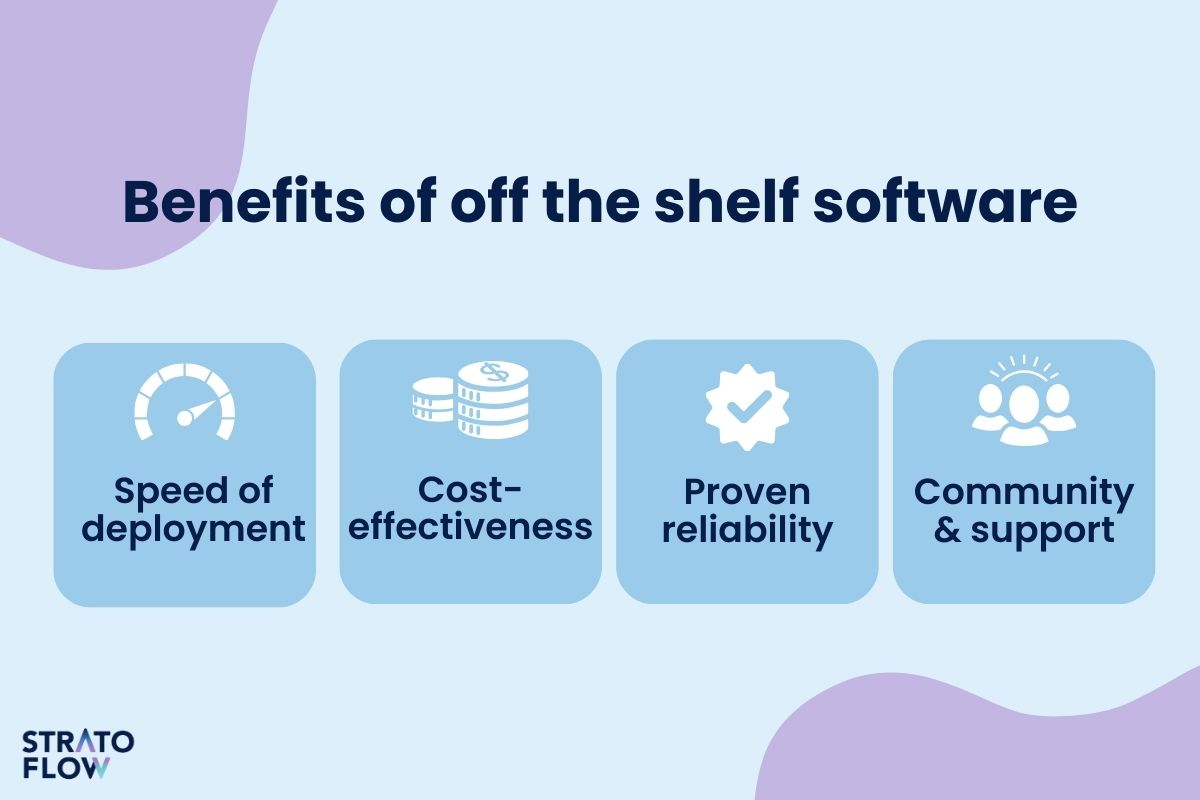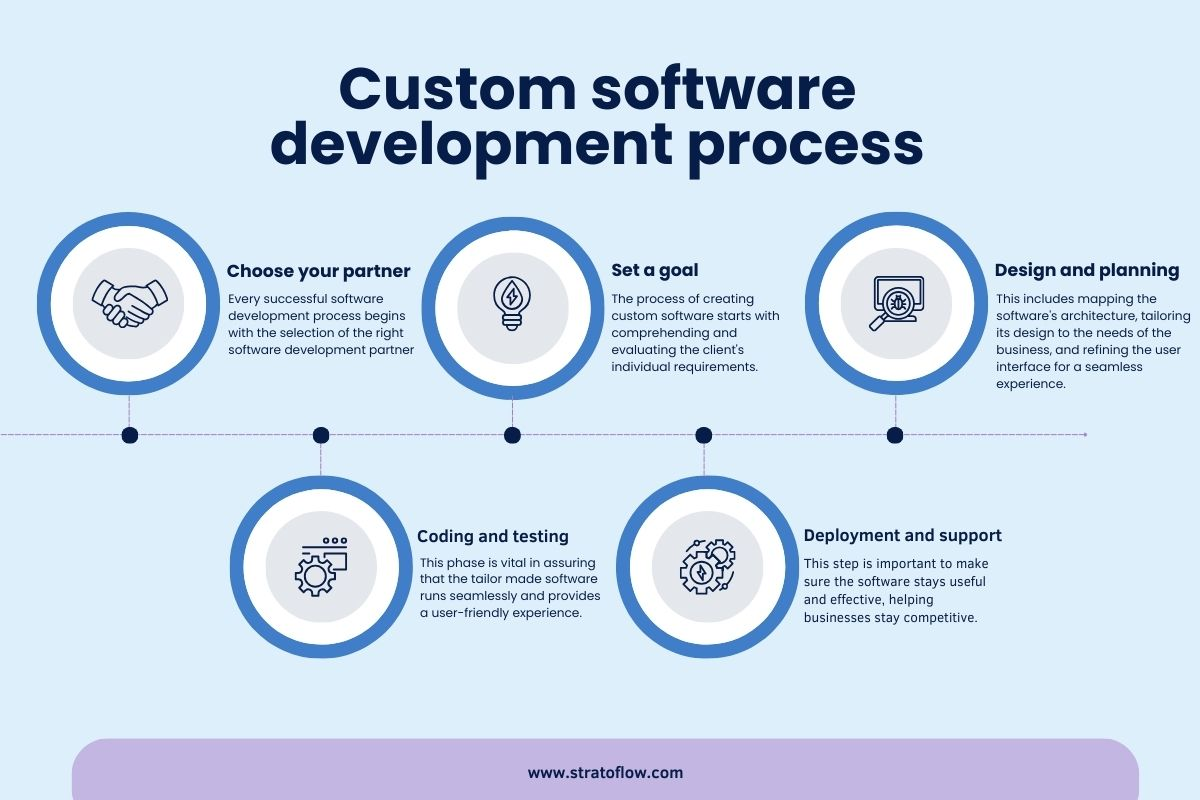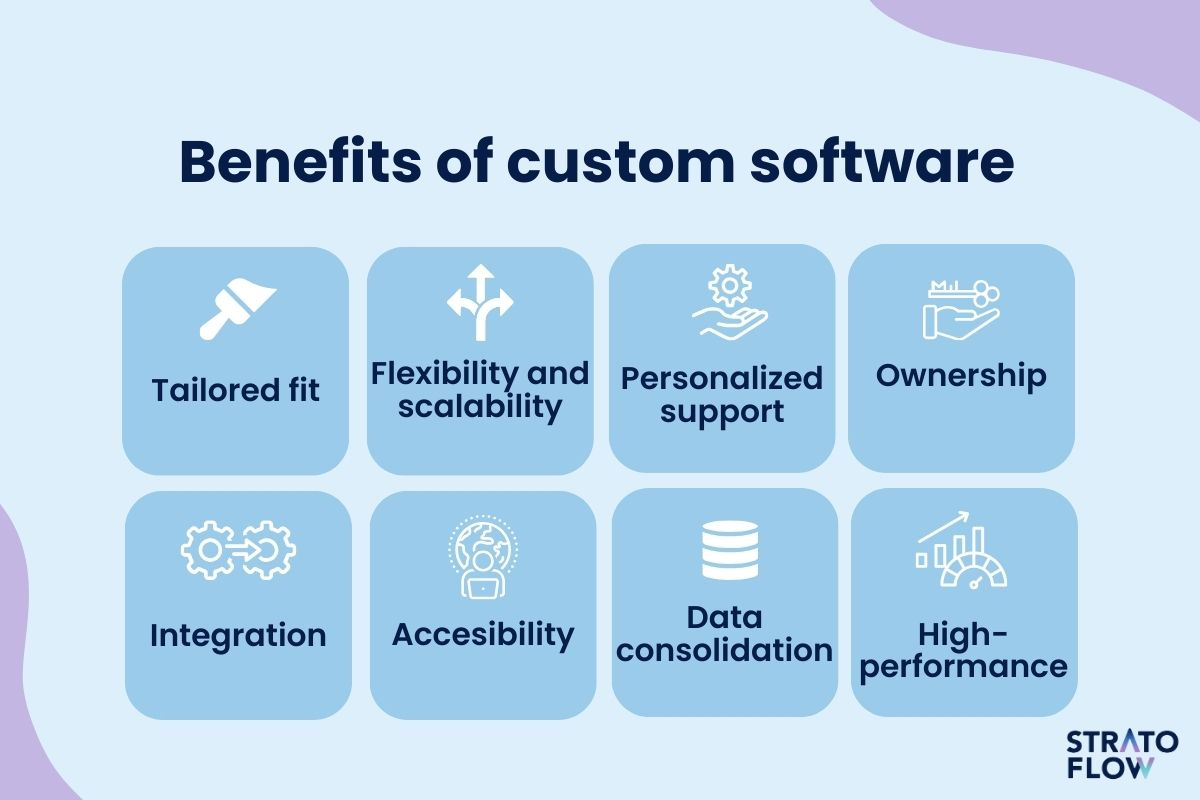
Off the Shelf vs Custom Software: Pros & Cons + Examples
In today’s era, companies have a crucial choice to make regarding powering their operations using software.
Should they choose off-the-shelf solutions or invest in custom development?
This article explores the complex world of software selection, comparing the bespoke precision of custom software with the broad accessibility of off-the-shelf options. We will discuss the pros and cons of each method, from the personalized and unique nature of custom development to the cost-efficiency and immediacy of off shelf software.
Contents
- What is off the shelf software?
- Advantages of off the shelf software
- Disadvantages of off the shelf software
- What is custom software?
- Custom software development process
- Advantages of custom software
- Disadvantages of custom software
- Custom software examples
- Openkoda: the alternative that combines benefits of off the shelf and custom software
What is off-the-shelf software?
Off-the-shelf, or out-of-the-box, software is a pre-packaged and commercially available software solution designed to serve a broad audience with common needs. Unlike custom software, which is designed to meet the specific needs of a particular company or user, off-the-shelf software solutions are ready-made and can be used by anyone who buys them.
This type of software solution is typically developed by companies to address the most common tasks and needs of potential users.
It is sold as is, with the same features available to all customers.
The main advantages of off-the-shelf business software are its immediacy and cost-effectiveness. It can be deployed quickly and is generally less expensive upfront than custom software. This is because the software development budget is spread across a large number of users.
However, it may not be a perfect fit for each company’s unique processes, and the hidden costs of licensing, updates, and potential customization can add up over time.
Examples of off-the-shelf software solutions
You’ll probably know hundreds of examples of off-the-shelf software but let’s take a quick look at 3 of the most popular examples of these programs present in companies across the world:
- Microsoft Office Suite: This is one of the most prevalent off-the-shelf software packages, including widely-used applications like Microsoft Word for document creation, Excel for spreadsheets, PowerPoint for presentations, and Outlook for email communication.
- Salesforce: Salesforce is a customer relationship management (CRM) platform that offers a suite of tools for sales, customer service, marketing automation, analytics, and application development, designed to serve businesses of all sizes.
- QuickBooks: QuickBooks by Intuit is a comprehensive accounting software package used by small to medium-sized businesses for managing invoices, tracking expenses, payroll processing, and financial reporting.
Advantages of off the shelf software
Speed of deployment
Above all else, with off-the-shelf software, you can start using it almost immediately after purchase. This is ideal when your business needs a solution quickly and doesn’t have the time to wait for custom software development.
Cost-effectiveness
The upfront cost of packaged software is usually lower than custom-built options. Since the development costs are shared across many users, it becomes more affordable for you.
Proven reliability
Off-the-shelf software is widely used and thoroughly tested. You can rely on its proven track record, with performance metrics and user feedback that give you confidence in its stability.
Community and support
With a large user base, you benefit from a robust community for support. You’ll have access to forums, user groups, and shared resources where you can find advice and solutions.

Disadvantages of off the shelf software
Generic solution
Off-the-shelf software is built to serve a broad audience, so it may not align perfectly with your business’s specific needs.
Limited customization
While you might be able to make some adjustments, off-the-shelf software often has limits on how much you can tailor it to fit your processes.
Over time, this could create inefficiencies or force you to find additional solutions to cover the gaps.
Ongoing costs
The initial price might seem low, but many off-the-shelf solutions come with ongoing subscription fees, maintenance costs, and charges for updates or support.
These can add up over time, potentially costing you more than a custom solution.
Compatibility and integration issues
Integrating off-the-shelf software with your existing systems can sometimes be tricky.
Compatibility issues may arise, requiring extra time and resources to resolve, which could offset the benefit of quick deployment.
No competitive differentiation
Using the same software as your competitors means you’re missing out on the chance to use technology as a unique advantage. Off-the-shelf solutions offer little opportunity for competitive differentiation.
Dependence on the vendor
Your business becomes reliant on the vendor for updates, support, and the future direction of the software.
If the vendor discontinues the product or goes out of business, your operations could be at risk.
What is custom software?
On the other side of this tech spectrum, we have custom software.
Custom software, also known as bespoke software or customized software, is made for a specific business or organization to meet their unique needs and operations.
Unlike off-the-shelf software, custom software is built from scratch to fit your business’s specific preferences, workflows, and integration requirements.
This makes sure that the software aligns closely with your business strategies and processes, and such software can evolve with your organization over time.
Custom software development process
To better comprehend the differences between custom software vs off-the-shelf solution, let’s take a closer look at what the entire custom software development process looks like.
1. Choose the right software partner
Every successful software development process begins with the selection of the right software development partner, a company that not only aligns with your business values, but also has the capability to deliver the right software solution. This critical selection step sets the tone for the entire project.
After reviewing offers and evaluating the cost of software development you select a software development company that meets your criteria. The next formal step is to sign a software development agreement. This agreement starts the process and lists the terms, responsibilities, and expectations for both parties.
It leads to the development of your custom built software.
[Read also: How to choose the right software development company]
2. Set a goal
Creating custom software begins with a critical step: understanding and assessing your specific needs. This initial phase is essential to develop software that aligns perfectly with your expectations.
At this point, software developers engage in detailed discussions with you to fully grasp your:
- Particular needs
- Corporate objectives
- Projected software results
This collaborative effort creates a detailed plan that includes:
- scope of the project
- development approach
- programming languages
- timelines
- technology stacks
- necessary resources
This phase of custom software development is key to ensuring that your expectations are not only met but exceeded.
3. Software design and planning
Next, the custom software development process moves into a vital stage of detailed design and strategic planning.
This includes:
- creating a detailed map of the software,
- outlining its elements, features, and user interfaces,
- customizing the design for the specific needs of the business,
- ensuring that the user experience is smooth and easy-to-use.
By collaborating closely with you and gathering regular feedback, the dedicated team can craft a design that is both functional and visually engaging.
Furthermore, the software’s architecture is essential for building it on a solid foundation, ensuring a clear structure for all its components and connections.
[Read also: Software development methodologies]
4. Coding and testing
Once your design and architecture are finalized, the development team moves into building and conducting rigorous software testing.
Here, coding begins, utilizing functional programming to bring your design to life while maintaining high-quality standards.
This phase is crucial to ensure your custom software runs smoothly and delivers a user-friendly experience.
Before launching, the software undergoes thorough testing to identify and resolve any problems or security vulnerabilities. By prioritizing testing and quality assurance, you can minimize the risk of software malfunctions and avoid potential operational disruptions.
5. Deployment and ongoing support
The final step in creating custom software is deploying it and keeping it maintained. In this stage of custom software development services, the software is officially released and becomes an integral part of the business’s operational ecosystem.
Alongside deployment, comprehensive software documentation is developed and provided. This documentation serves as a roadmap for users and maintainers, detailing the software’s functionality, configuration, and troubleshooting procedures. It is an essential tool for enabling users to understand and effectively utilize the software, as well as for developers to maintain and update the system efficiently.
The development team is available to provide ongoing support and updates.
This step is important to make sure the software stays useful and effective, helping businesses stay competitive. By providing thorough guides and training to users, companies can make the most of their customized software, resulting in a solid return on investment.

[Read also: Future of software engineering]
Advantages of custom software
Tailored fit
Custom software is built to match your organization’s specific business processes.
Every feature and function is crafted to support your unique workflows, user roles, and business rules. Unlike off-the-shelf software that forces you to adjust to its limitations, custom software adapts to you, offering complete personalization.
Flexibility
As your business grows and evolves, custom software can be easily updated and expanded to keep pace with changes in your operations and technology. This adaptability ensures your software remains relevant and useful for the long term.
Competitive advantage
Custom enterprise software is designed specifically for your business, giving you a competitive edge in your industry.
It provides unique functionality that your competitors won’t have, offering you a distinct advantage in efficiency, innovation, and overall performance.
Ownership
With custom software, you have complete ownership of the solution.
This means you control how the software is used, modified, or expanded without any restrictions, giving you the freedom to adapt it as your business needs change. You also don’t have to fear vendor-lock find and user-based pricing – a perfect solution for rapidly growing businesses.
Long-term cost benefits
While custom software may have a higher initial cost, it often leads to significant long-term savings. Unlike off-the-shelf solutions that require ongoing subscription fees, custom software is a one-time investment that pays off over time through greater efficiency and lower operational costs.
Personalized support
Working with a custom software provider often means more personalized support. They have a deeper understanding of your business and can provide tailored support, which can be invaluable in maintaining your existing systems and enhancing the software.
Scalability
When you work with a custom software provider, you benefit from personalized support.
Your provider understands your business deeply and can offer tailored assistance to maintain and enhance your systems, helping you get the most out of your investment.
Integration with other systems
Custom solutions can be made to easily integrate with the software and tools your company already uses. This allows data to flow effortlessly between platforms, reducing the need for manual data entry, cutting down errors, and saving you time.
Streamline business automation
Custom software automates repetitive tasks, freeing you to focus on your core business activities.
By integrating different data sources and connecting with third-party applications, your software partner can help you streamline operations and accelerate growth.
Data consolidation
Eliminate the chaos of managing multiple spreadsheet versions. Custom software development ensures that your data is stored, updated, and managed in a consistent and organized manner. Embrace the modernization of your existing software or business processes and leave outdated methods behind for a more streamlined and error-free data management system.
Improved business intelligence
Custom software delivers powerful, data-driven insights, enabling you to access real-time business metrics in one place.
This ensures you always have accurate, up-to-date information to make informed decisions that drive your business forward.
High-performance solutions
Custom software development focuses on creating fast and efficient computing solutions that meet your business needs.
The software is custom-built for high-performance and resource efficiency, striving to exceed speed and performance expectations in the fast-paced digital world. Even a millisecond can impact productivity and user experience, making optimal software crucial. This is accomplished by using the most efficient and eco-friendly programming languages, keeping the environment in mind. This provides businesses with a competitive advantage that is both technologically advanced and environmentally friendly.
[Read also: Latest software development trends]

Disadvantages of custom software
Higher upfront investment
Customized software development requires a significant upfront investment due to the resources required to develop it from scratch. This can be a significant financial commitment, especially for small or medium-sized businesses.
Longer development time
The process of developing custom software can be lengthy, often taking several months. This timeframe may not be feasible for companies that need an immediate solution. However, you can learn how to speed up the software development process.
Potential developer dependency
Custom software can create a dependency on the original developers for updates, support, and maintenance. If the vendor becomes unavailable or goes out of business, the continued use and functionality of the software could be at risk.
Risk of complexity
With the ability to customize every aspect of the software, there’s a risk of creating a solution that is too complex or difficult to use without extensive training.
Project risk
Custom software projects come with their own set of risks, including the potential for the project to go over budget, deliver late, or fail to meet business needs if not managed properly.
Custom software development statistics
According to Grand View Research, the global custom software development market size was valued at USD 29.29 billion in 2022. It is expected to expand at a compound annual growth rate (CAGR) of 22.4% from 2023 to 2030. It is estimated that 58% of the market belongs to the large, enterprise segment, and 36% of the market is the market share of only North America. According to GM Insights, the demand for tailored software solutions, such as Enterprise Resource Planning (ERP) systems, is propelling custom software market growth.
On average, custom software development costs from 30000 USD for small-scale projects to over 1000000 USD for large enterprise-grade software systems. Software development project takes roughly between one to nine months. On average, a custom software development project is expected to take about 5 months but some, large software projects can take years with constant updates and the addition of new functionalities.
Custom software examples
1. Custom software solution for finance
Secure and scalable Software as a Service (SaaS) financial platform a great demonstration of how creating custom software applications can address the unique needs of a specific industry, in this case – finance industry.
This custom built software can manage large and complex financial transactions and calculations, giving a client competitive edge.
This finance system was made to deliver features that other financial software can’t offer. It was created to ensure fast processing, handle growth without slowing down, and uphold high security for financial operations.
Custom software provides a unique solution, that perfectly matches business needs, giving a competitive advantage in your industry. This case study highlights the benefits of customized options. Off-the-shelf software is useful and economical for general purposes, but custom software prioritizes performance, scalability, and security for industry-specific requirements.
Read entire case studies here: High-performance, horizontally scalable cloud platform for financial applications.
Another example is custom accounting software.
Such solution provides a structure that is finely tuned to a company’s unique financial management and reporting needs. It improves operational efficiency by streamlining specialized processes and minimizing the likelihood of manual errors.
Over time, these efficiencies will lead to additional cost reductions that may not be immediately apparent.
2. Customized solutions for travel
Another successful custom software development solution is a travel search engine created for a major hotel booking aggregator company.
This custom travel search engine can handle real-time price and availability calculations. It is designed to be highly scalable. It can easily process large amounts of data associated with travel bookings, such as flight prices and hotel room availability.
The custom product was made to not just handle a large amount of data but also guarantee that the information given to users is current and correct, which is crucial in the rapidly changing travel industry. This shows the strength of customized software when pre-made alternatives cannot fulfill the intricate needs of a specific business in travel industry.
If you want to learn more about this project, read our case studies: Travel search engine handling 300 million queries daily.
3. Custom software solutions for ecommerce
Let’s talk about custom solutions for ecommerce sector.
Another example proving that custom software can be indispensable is an ecommerce pricing engine that connects to outside pricing sources, providing the foundation for an omnichannel ecommerce platform. This complex system adjusts prices in real-time, keeping up with market trends and outside data.
The specially designed system helps the online shopping site offer the same prices in all mediums, including the website, the app, and physical stores. This ensures a smooth and understandable purchasing event for customers.
The example illustrates how custom software can make a significant difference in the world of business, specifically when dealing with dynamic, real-time data merging and the requirement for consistency in customer-facing interfaces. It shows how personalized software can be used to tackle particular business requires and difficulties, supplying a resolution that pre-packaged programs frequently cannot offer.
Read more: Real-time pricing engine integrated with external pricing feeds driving an omnichannel e-commerce platform.
Openkoda: the alternative that combines benefits of off the shelf and custom software
We’ve looked at the pros and cons of both off-the-shelf and custom software.
Now let’s explore Openkoda, a platform that combines the best of both worlds. It’s changing the game for building enterprise applications in Java, making the process much faster than traditional methods.
Openkoda provides out-of-the-box modules that simplify development like low-code platforms do, but it still allows for customization with less programming. Its special feature is an AI-powered engine that speeds up the creation of new, custom features and helps developers with an AI Companion.
A big benefit of Openkoda is that it doesn’t lock you into a single cloud service or vendor. Companies have full control over their code and can deploy their applications wherever they want. Openkoda is designed to build applications that are secure, can grow with your business, and can be developed quickly.
And most importantly, Openkoda works for many industries. It can build custom software for insurance companies, time management tools, legal tech, and more, making it a versatile choice for companies looking to lead in their field.
Want to give a try? Schedule a personalized demo.

Related Posts
Thank you for taking the time to read our blog post!